
Messier 107 or M107, also known as NGC 6171 or the Crucifix Cluster, is a very loose globular cluster in a very mildly southern part of the sky close to the equator in Ophiuchus, and is the last such object in the Messier Catalogue.

Omega Centauri is a globular cluster in the constellation of Centaurus that was first identified as a non-stellar object by Edmond Halley in 1677. Located at a distance of 17,090 light-years, it is the largest known globular cluster in the Milky Way at a diameter of roughly 150 light-years. It is estimated to contain approximately 10 million stars, with a total mass of 4 million solar masses, making it the most massive known globular cluster in the Milky Way.
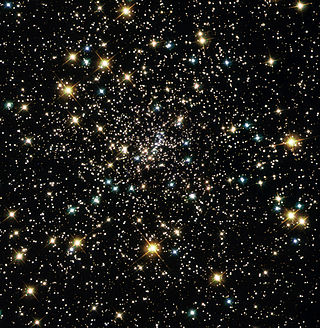
NGC 6397 is a globular cluster in the constellation Ara that was discovered by French astronomer Nicolas-Louis de Lacaille in 1752. It is located about 7,800 light-years from Earth, making it one of the two nearest globular clusters to Earth. The cluster contains around 400,000 stars, and can be seen with the naked eye under good observing conditions.
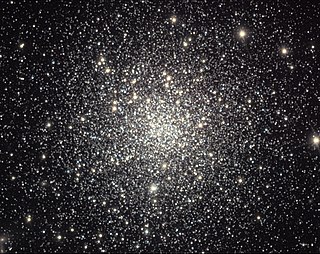
Messier 12 or M 12 is a globular cluster in the constellation of Ophiuchus. It was discovered by the French astronomer Charles Messier on May 30, 1764, who described it as a "nebula without stars". In dark conditions this cluster can be faintly seen with a pair of binoculars. Resolving the stellar components requires a telescope with an aperture of 8 in (20 cm) or greater. In a 10 in (25 cm) scope, the granular core shows a diameter of 3′ (arcminutes) surrounded by a 10′ halo of stars.

Messier 53 is a globular cluster in the Coma Berenices constellation. It was discovered by Johann Elert Bode in 1775. M53 is one of the more outlying globular clusters, being about 60,000 light-years (18.4 kpc) light-years away from the Galactic Center, and almost the same distance from the Solar System. The cluster has a core radius (rc) of 2.18 pc, a half-light radius (rh) of 5.84 pc, and a tidal radius (rtr) of 239.9 pc.

Messier 62 or M62, also known as NGC 6266 or the Flickering Globular Cluster, is a globular cluster of stars in the south of the equatorial constellation of Ophiuchus. It was discovered in 1771 by Charles Messier, then added to his catalogue eight years later.

Messier 70 or M70, also known as NGC 6681, is a globular cluster of stars to be found in the south of Sagittarius. It was discovered by Charles Messier in 1780. The famous comet Hale–Bopp was discovered near this cluster in 1995.
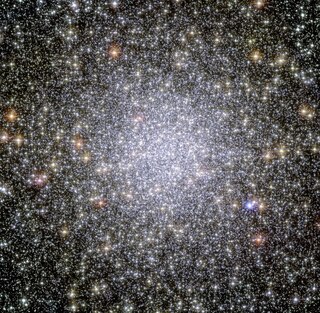
47 Tucanae or 47 Tuc is a globular cluster located in the constellation Tucana. It is about 4.45 ± 0.01 kpc (15,000 ± 33 ly) from Earth, and 120 light years in diameter. 47 Tuc can be seen with the naked eye, with an apparent magnitude of 4.1. It appears about 44 arcminutes across including its far outreaches. Due to its far southern location, 18° from the south celestial pole, it was not catalogued by European astronomers until the 1750s, when the cluster was first identified by Nicolas-Louis de Lacaille from South Africa.

NGC 2419 is a globular cluster in the constellation Lynx. It was discovered by William Herschel on December 31, 1788. NGC 2419 is at a distance of about 300,000 light years from the Solar System and at the same distance from the Galactic Center.

NGC 3201 is a low galactic latitude globular cluster in the southern constellation of Vela. It has a very low central concentration of stars. This cluster was discovered by James Dunlop on May 28, 1826 and listed in his 1827 catalogue. He described it as "a pretty large pretty bright round nebula, 4′ or 5′ diameter, very gradually condensed towards the centre, easily resolved into stars; the figure is rather irregular, and the stars are considerably scattered on the south".

NGC 5466 is a class XII globular cluster in the constellation Boötes. Located 51,800 light years from Earth and 52,800 light years from the Galactic Center, it was discovered by William Herschel on May 17, 1784, as H VI.9. This globular cluster is unusual insofar as it contains a certain blue horizontal branch of stars, as well as being unusually metal poor like ordinary globular clusters. It is thought to be the source of a stellar stream discovered in 2006, called the 45 Degree Tidal Stream. This star stream is an approximately 1.4° wide star lane extending from Boötes to Ursa Major.

NGC 5986 is a globular cluster of stars in the southern constellation of Lupus, located at a distance of approximately 34 kilolight-years from the Sun. It was discovered by Scottish astronomer James Dunlop on May 10, 1826. John L. E. Dreyer described it as, "a remarkable object, a globular cluster, very bright, large, round, very gradually brighter middle, stars of 13th to 15th magnitude". Its prograde–retrograde orbit through the Milky Way galaxy is considered irregular and highly eccentric. It has a mean heliocentric radial velocity of +100 km/s. The galacto-centric distance is 17 kly (5.2 kpc), which puts it in the galaxy's inner halo.
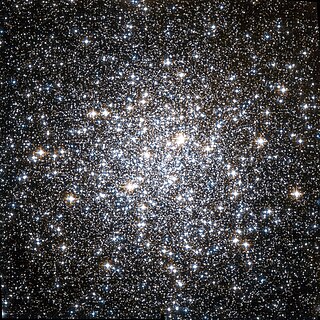
NGC 6723, also known as the Chandelier Cluster, is a globular cluster in the constellation Sagittarius. Its magnitude is given as between 6 and 6.8, and its diameter is between 7 and 11 arcminutes. It is a class VII cluster with stars of magnitude 14 and dimmer. It is near the border of Sagittarius and Corona Australis.

NGC 2808 is a globular cluster in the constellation Carina. The cluster currently belongs to the Milky Way, although it was likely stolen from a dwarf galaxy that collided with the Milky Way. NGC 2808 is one of our home galaxy's most massive clusters, containing more than a million stars. It is estimated to be 12.5-billion years old.

NGC 1851 is a relatively massive globular cluster located in the southern constellation of Columba. Astronomer John Dreyer described it as not very bright but very large, round, well resolved, and clearly consisting of stars. It is located 39.5 kilolight-years from the Sun, and 54.1 kilolight-years from the Galactic Center. The cluster is following a highly eccentric orbit through the galaxy, with an eccentricity of about 0.7.
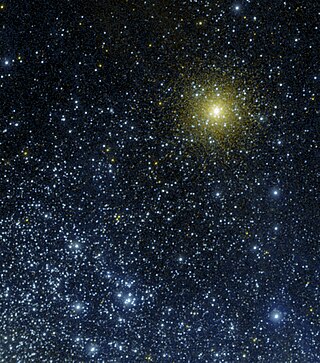
NGC 362 is a globular cluster located in the constellation Tucana in the Southern Hemisphere, slightly north of the Small Magellanic Cloud, to which it is completely unrelated. It was discovered on August 1, 1826, by James Dunlop. It is visible to the naked eye in dark skies, and is an impressive sight in a telescope, although it is somewhat overshadowed by its larger and brighter neighbour 47 Tucanae.
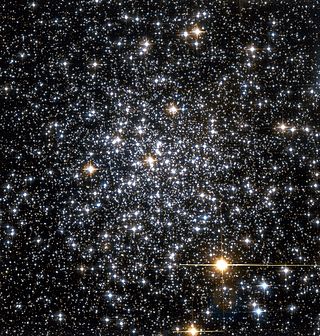
NGC 6352 is a globular cluster of stars in the southern constellation of Ara, located approximately 18.3 kly from the Sun. It was discovered by Scottish astronomer James Dunlop on May 14, 1826. The cluster has a Shapley–Sawyer Concentration Class of XI:. A telescope with a 15 cm (5.9 in) aperture is required to resolve the stars within this loose cluster.

NGC 6541 is a globular cluster of stars in the southern constellation of Corona Australis. The globular cluster was discovered by Niccolò Cacciatore at the Palermo Astronomical Observatory, Sicily, on March 19, 1826. It was independently found by James Dunlop on July 3, 1826. The cluster has an apparent visual magnitude of 6.3 and an angular diameter of 15′. It is visible with binoculars or a small telescope.

NGC 6388 is a globular cluster of stars located in the southern constellation of Scorpius. The cluster was discovered by Scottish astronomer James Dunlop on May 13, 1826 using a 20 cm (9 in) reflector telescope. It was later determined to be a globular cluster by English astronomer John Herschel, who was able to resolve it into individual stars. NGC 6388 is located at a distance of approximately 35,600 light-years (10.90 kpc) from the Sun. Due to its apparent visual magnitude of +6.8, binoculars or a small telescope are required to view it.

NGC 3256 is a peculiar galaxy formed from the collision of two separate galaxies in the constellation of Vela. NGC 3256 is located about 100 million light-years away and belongs to the Hydra–Centaurus Supercluster complex. NGC 3256 provides a nearby template for studying the properties of young star clusters in tidal tails. The system hides a double nucleus and a tangle of dust lanes in the central region. The telltale signs of the collision are two extended luminous tails swirling out from the galaxy. The tails are studded with a particularly high density of star clusters. NGC 3256 is the most luminous galaxy in the infrared spectrum located within z 0.01 from Earth.





















